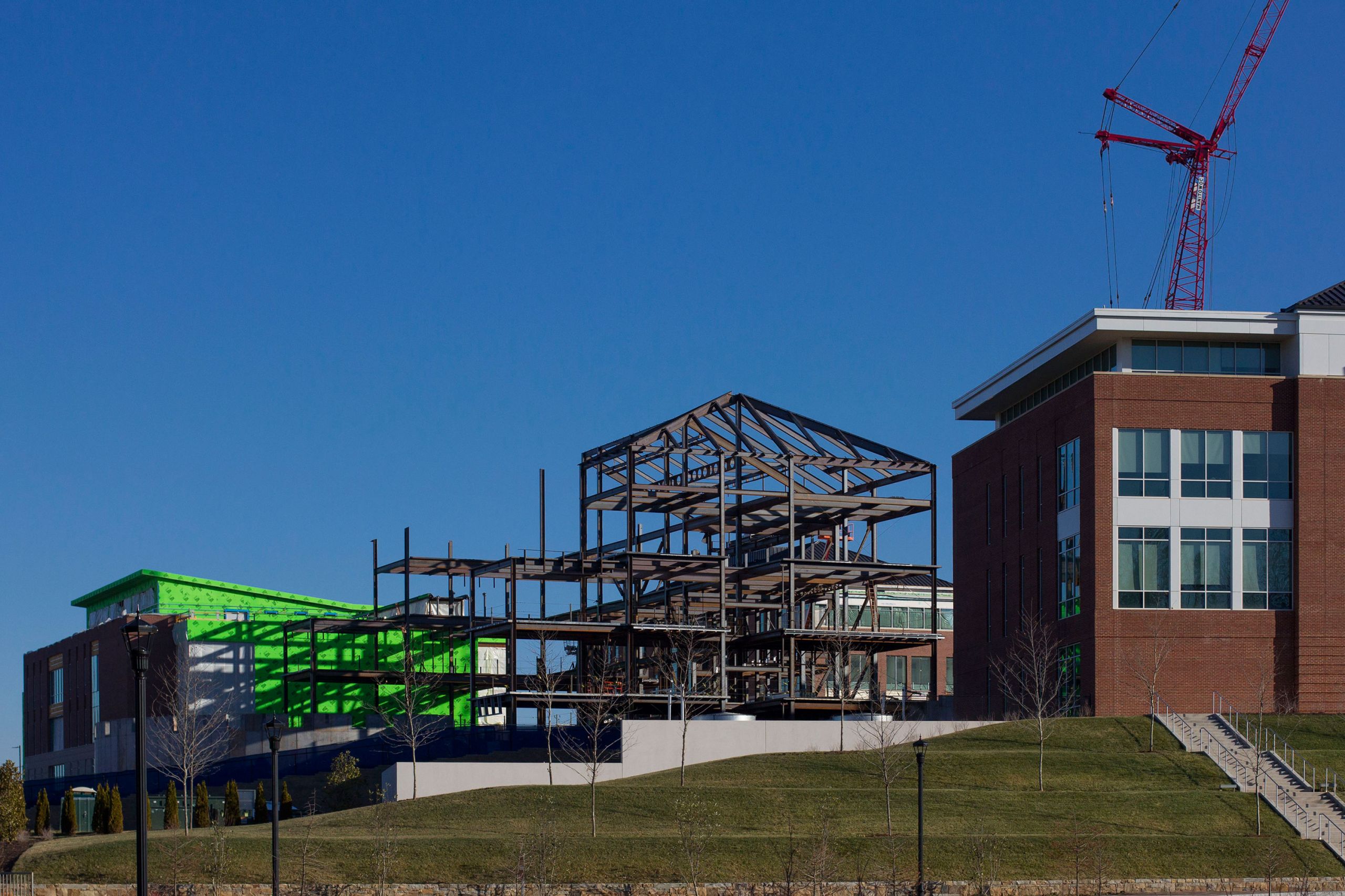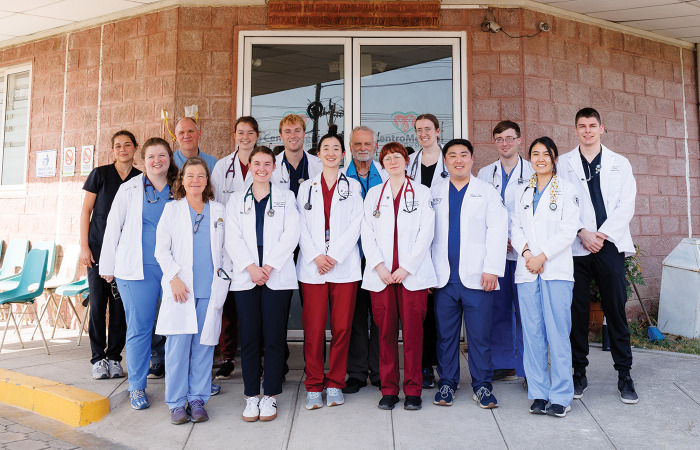Liberty has grown at an unprecedented rate over the last 43 years and, most notably, over the past decade. Today Liberty is the largest private, nonprofit university in the nation, the largest university in Virginia, and the largest Christian university in the world. Over 13,500 students are currently studying on campus, and the university anticipates a residential population of 16,000 within the decade.
In order to accommodate the burgeoning student body on Liberty’s campus, the Master Plan — an architectural proposal outlining the addition of 13 new academic, residential, and athletic facilities — is nearing finalization. With the amount of both new construction and campus renovations, it became clear that the magnitude of the project would require a new management approach.
Liberty’s own Department of Planning and Construction (P&C), headed by Senior Vice President for Construction Planning Charles Spence, had managed campus construction for decades. As administration considered the best way to move forward into increasingly state-of-the-art, specialized facilities, they began to seek out avenues through which they could expand their capacity while maintaining direct involvement in projects.
In keeping with the school’s tradition of entrepreneurship and dedication to quality and integrity, Liberty’s leadership decided to adopt a “Construction Management as Agent” approach and worked with experienced construction professionals to create a new construction company dedicated solely to Liberty University projects.
This model is very common in the construction industry, especially in higher education. In 2012, the Construction Management Association of America (CMAA) conducted a research study (through McGraw Hill Construction) that included 266 projects utilizing this model. Eighty-five of these projects, totaling more than $2 billion, were for higher education projects, with an average cost per project of $23.8 million. The study concluded that “Owners working with professional Agency CM experience smoother, more trouble-free projects characterized by leadership, communication, and met expectations.”
It was this communication and ability to meet each other’s expectations that prompted Liberty University’s leadership to collaborate with construction professionals Bobby Moon and Phil Kirby to form a new company, Construction Management Associates (CMA), to serve as Liberty’s Construction Manager as Agent. Moon and Kirby were chosen for the great deal of experience they possessed in constructing large, complex, higher education projects and their comprehensive understanding of the construction industry. Moreover, they understand Liberty’s goals and can ensure that the construction delivered meets the university’s standards of quality.
The Construction Manager as Agent approach allows Liberty’s P&C Department, CMA, and its architects to act as a single entity in achieving construction cost, schedule, and quality goals. The two teams are co-located on campus, a situation that facilitates continuous communication and coordination from project initiation through planning, design, and construction. They are currently working together on 13 projects that are in various stages of planning, design, or construction.
Under the Construction Manager as Agent model, fast-tracking projects and phasing work are more manageable and often result in construction being completed ahead of schedule.
This new model of operation will not only save the university time — projects will run smoother by having a single entity managing projects and securing subcontractors — but will also draw from CMA’s extensive experience on similar construction projects, using “lessons learned” to reduce learning curves and maximize favorable outcomes. The model allows the university to negotiate better business terms on materials such as concrete and brick, as well as fuel and construction insurance. CMA and the P&C Department are also able to share Liberty’s in-house construction resources, as available, which significantly reduces cost.
In addition, Liberty has been able to institute some of the more cutting-edge concepts in the construction industry. By utilizing multiple-project Owner-Controlled Insurance Programs (OCIP) and acting within the tenets of an integrated project delivery methodology, Liberty has eliminated some of the typical contractual barriers and conflicts of traditional construction models — a freedom that is aspired to by many other institutions.
“In the 30 years I have been involved in facilities operation and development on campus,” said Charles Spence, Liberty’s senior vice president for construction planning, “our current facility development process has never run smoother, largely due to the architect, constructor, and university personnel working together closely from day one of project initiation through construction completion. The result has been that facilities are brought on quicker and within budget and at top-level quality.”
Program Achievements
This approach to managing the construction of an ever-growing campus is not only innovative, but good stewardship of available resources. The recently renovated Reber-Thomas Dining Hall was completed — from concept to serving meals — in just four months. With P&C and CMA together managing the design process, value-engineering the mechanical and electrical systems, negotiating equipment purchases, and utilizing Liberty’s maintenance staff for some of the construction, the updated facility was completed seven percent below the $4.2 million budget.
Now they are working together on the School of Music (SOM), which is also targeted to result in a five to seven percent savings on the anticipated budget. Classrooms for the SOM are scheduled to open August 2015 with the 1,600-seat concert hall opening February 2016. Additional cooperative projects include the DeMoss Student Center expansion and the Liberty University College of Osteopathic Medicine’s new medical services center (opening Spring 2015), as well as the Wingate Hotel conversion to Fairfield Inn & Suites.
Another large-scale project currently using the Construction Management as Agent approach is the second high-rise Residential Commons. The first Residential Commons was completed in 20 months; however, with fast-track construction of the second dormitory — utilizing “lessons learned” on the first residence hall and adding improvements to design — its first phase is targeting completion in 12 months. This will make it possible to close both the Annex and Annex II, off-site hotels that have been serving as residence halls, by the end of 2015, bringing the student body together on campus and keeping up with expected enrollment growth.
The collaboration between Liberty’s P&C Department and CMA also affords them the unique ability to do comprehensive pre-construction-phase planning and review related to cost, schedule, and logistic analysis during design development. The construction management model reduces change orders and associated costs that are common in a traditional construction process. Campus projects currently in pre-construction include the Campus Landmark Tower, Athletic Performance Center, Library Chiller addition, third Residential Commons building, and landscaping of the Academic Lawn that will lie between the Science Hall, School of Music, DeMoss Student Center, and Jerry Falwell Library.
“The size and scope of the construction projects currently underway at Liberty University are truly historic. We have been blessed with the rare opportunity to build a university campus almost from scratch — the type of opportunity that occurs in this country maybe once or twice in a generation,” said President Falwell. “English Construction Company, Branch Construction Company, Glass Constructors, Coleman-Adams Construction, and many other fine firms have successfully and competently completed the first phase of our campus reconstruction. Liberty has been well served by all of these local companies and, while Liberty will continue to employ all of their services on future projects, we are confident that the Construction Management as Agent approach with CMA is the right choice for Liberty’s construction of the remaining core campus facilities in the Master Plan.”
Who is CMA?
CMA is owned by principals Bobby Moon, president, and Jackie Moon.
Bobby Moon and Director of Operations Phil Kirby have more than 40 years of experience in managing collegiate and private construction projects not only in Virginia, but also in Pennsylvania, Maryland, and North Carolina. They have also worked together on more than $500 million of higher education projects for the University of Virginia and Virginia Tech.
Moon is also very familiar with construction at Liberty, having erected the steel framework and rigging for the university and related entities on and around the campus over the last 15 years, including Thomas Road Baptist Church, Jerry Falwell Library and, most recently, the first Residential Commons. As a toddler, Moon even sat in the crane with his dad in 1970 as his family’s company erected the steel for the Thomas Road Baptist Church main sanctuary on Thomas Road. Kirby has managed well over 1 billion dollars of construction, including more than a half billion dollars of construction on large, complex projects for the University of Virginia from 1993 to 2013.
CMA currently has more than 20 experienced on-site project professionals, including estimators, senior project managers, and superintendents working on construction and pre-construction projects at Liberty University.






